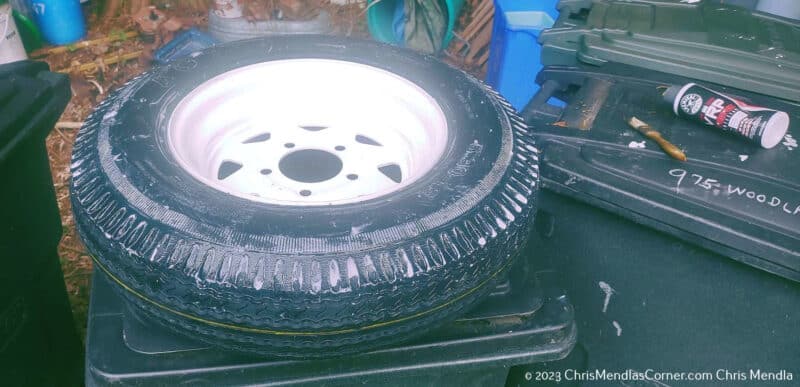Last Updated on 2 years by Christopher G Mendla
Learn how to replace wheels on your Harbor Freight utility trailer with our step-by-step guide. Ensure safety and reliability for your outdoor adventures. DIY trailer wheel replacement made easy.
Overview
Maintaining your utility trailer is vital for its lifespan and optimal performance, especially if it has been stored outside. I built my Harbor Freight utility trailer in February 2017. I store the trailer outside. Trailers should be routinely inspected for any components that require replacement, including wheels and tires. I recently noticed some concerning dry rot in my tires while applying weather protectant. This discovery spurred me to replace them to ensure safety and reliability on the road.
The Problem – Dry Rot
As I applied a weather protectant to my trailer’s tires, I was shocked at how much dry rot I found. I ordered two new tires along with a spare tire carrier so I could reuse one of the old tires as a spare. I also purchased two wheels (tire/rim combination) and an additional mounting bracket as additional measures of convenience.
Purchasing replacement tires
Harbor Freight does not seem to be selling their utility trailers in Pennsylvania due to idiotic regulations for registering a trailer. There were some stores that seemed to have the tires in stock. I opted to purchase the new tires/wheels from Amazon. WARNING – Be sure that the tires are compatible with your trailer.
Applying Weather Protectant to the new tires and Tackling Tire Replacement:
To start the replacement process, I applied weather protectant to each new tire with a small paintbrush. This ensured it reached all areas of the treads and crevices to provide complete protection from the elements. The protectant is the consistency of sunscreen.
Afterwards, using an air wrench, I removed my old tire. This step proved simple yet highlighted the importance of timely maintenance to prevent further deterioration of the tires.
Greasing the Hub and Installing the New Tire:
According to the owner’s manual for my trailer, applying grease on the inner side of its hub was recommended in order to protect its bearing seal. Once I removed my old tire from its place, this step was straightforward. Adding grease here helps ensure that the seal remains pliable. Installing my new tire onto its rim was simple too and further demonstrated the value of quality parts for long-term reliability.
Precision Tire Reinstallation:
Once I had installed my new tire and greased up my hub, it was time to reattach them to my trailer. Per the manual’s specifications of 85-90 foot pounds torque requirement, using a torque wrench was essential in maintaining wheel stability during travel and avoiding potential accidents caused by loose wheels.
Addressing Wheel Bore Diameter Differences:
An intriguing aspect of my replacement journey was addressing discrepancies between center bore diameter of new and original wheels. While there was some ambiguity surrounding this variation, most experts concurred it was safe. While one-size-fits-all replacement wheel options might lead to differences, it is essential that any deviations are explored prior to proceeding.
Considerations and the Importance of Operating Pressure:
One option I considered was buying only the tire part and installing it myself, however with my operating pressure set at 80 PSI this choice provided both greater pressure stability and an easier replacement process.
Conclusion:
Replacing the wheels on your Harbor Freight utility trailer might seem to require a good bit of work, but with proper planning and attention to detail it can become manageable and rewarding. Regular inspections and timely replacement are key for the safety and performance of any trailer. By following the steps outlined here and conducting extensive research when encountering variations from original equipment you can feel secure that your utility trailer remains roadworthy for hauling needs. I am going to look into protective covers for the tires.
I took one of the wheels I removed and mounted it as a spare.




